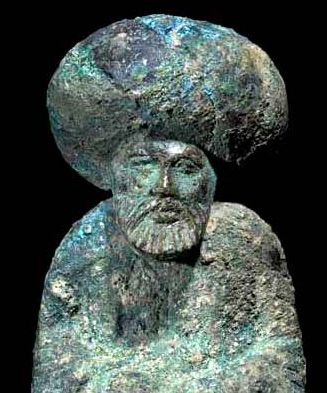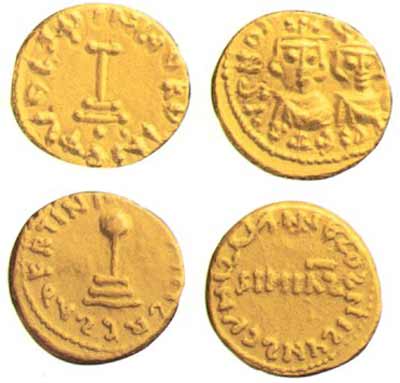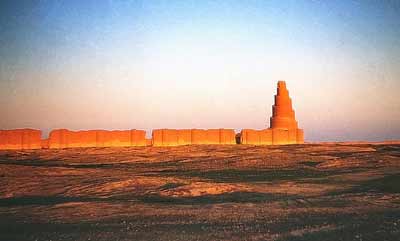
Bronze Chess Piece of the
Caliph Harun al-Rashid
Neil Faulkner Archive | ETOL Main Page
Marxist History
Published online by Counterfire, 29 November 2010.
Copied with thanks from the Counterfire Website.
Marked up by Einde O’Callaghan for the Encyclopaedia of Trotskyism On-Line (ETOL).
Islam created a single overarching allegiance throughout the Arab-ruled world yet the Middle East came to be a divided region of weak and unpopular states. Neil Faulkner looks at the conflicts that lay behind this process.

Bronze Chess Piece of the |
The Arab conquests which began in 632 CE (common era) eventually gave Arab rulers and their warrior retinues control of territories that stretched from the Atlantic to Afghanistan. They inherited the wealth of Byzantine Syria, Sassanid Iraq, and Visigothic Spain. Such accretions of power and wealth made a social order based on desert tribes and the caravan trade unsustainable.
The Islamic Empire remained united immediately after Muhammad’s death under the leadership of the first caliph (or ‘successor’), Abu Bakr, but the second caliph, Umar, was murdered in 644 CE, the third, Uthman, in 656 CE, and the fourth, Ali, in 661 CE.
The crisis of 658–661 CE was decisive. Ali was overthrown after a full-scale civil war, and not only was he murdered, but also his son, Husein, some 19 years later. The victor of the dynastic struggle was Mu’awiya, who founded the Damascus-based Umayyad dynasty in the year of Ali’s murder.
These apparently obscure events matter. Ali was the son-in-law of the Prophet. Mu’awiya was a cousin of the murdered caliph Uthman, another onetime intimate of Muhammad. The Islamic politico-religious elite was tearing itself apart.
The split would never heal. There is a direct line from Uthman and Mu’awiya to today’s Sunni Muslims, and from Ali and Husein to today’s Shi’ites.
The Umayyads wanted to enjoy the fruits of empire. The followers of Ali and Husein wanted to preserve the purity of early Islam. This was, in part, a class split, and the Sunni-Shi’ite division retains something of this character today.
For a century, the Umayyads retained power, held the empire together, and exploited the wealth and skills of the old civilisations. The Arab world enjoyed rich irrigation agriculture, sophisticated urban crafts, a dynamic banking system, and a strong tradition of scholarship, literature, and art. The Western world, by contrast, was living in ‘the Dark Ages’.
Two contradictions undermined the Umayyad Empire and eventually brought it down. First, the geography of the Arab world contained several natural economic units, in which separate ruling classes with interests of their own rapidly developed. Distance limited the effectiveness of Umayyad rule. How could armies in Damascus expect to control Baghdad, Cairo, Tunis, and Fez?

Umayyad palace in Amman |
Second, the Umayyads represented the Arab warrior aristocracy which had carried out the original Islamic conquests and then settled in the ancient cities of Syria. This elite built themselves palaces and spent lavishly on architecture, art, and luxury goods.
They were supported by the Arab rank-and-file, settled in garrison-towns, exempt from taxation, and supported by pensions paid for out of booty and tribute. The Umayyad ruling class was small and parasitic, and it rested on a narrow base of military freeloaders.
But the economy was booming. War between the old empires had devastated farms, disrupted trade, and drained away taxes and manpower. The Pax Islamica meant that agriculture and trade flourished, ancient towns hollowed out by decay were transformed into commercial powerhouses, and the merchant and artisan classes grew in numbers, prosperity, and assertiveness. Here were the social roots of a new revolution.
Many converted to Islam. Keen to limit the number exempt from taxation, however, the Umayyads created a new category of second-class Muslims: new converts were designated mawali and excluded from Arab privilege.

Early Umayyad coins |
By the middle of the 8th century CE, the Arabs were a small military aristocracy living off the tribute paid by a growing mass of urban-based Muslim merchants and artisans. The latter provided a ready audience for Islamic dissidents like the Shi’ites, the yet-more-radical Kharijites, and various messianic mahdis (‘guided ones’).
None of the dissident movements was strong enough to break the power of the Umayyad state; they merely expressed the social discontent and symbolised its instability. What was decisive was an opportunist split in the Arab ruling class.
Abu-I-Abbas, a descendant of Muhammad’s family, built an underground network of supporters in Iraq, placed himself at the head of the various dissident groups, and then launched an Islamic insurrection to overthrow the Umayyad dynasty.
The Umayyads were defeated, and a new Abbasid dynasty was founded in 750 CE, with its capital in Baghdad.
Power passed to a more broadly-based and inclusive urban elite of officials, merchants, and Islamic scholars and clerics. Arab ethnicity and warrior status lost much of their significance. Agriculture, trade, and towns continued to grow.
Even so, the two contradictions of Early Islamic empire soon reasserted themselves, albeit on a more elevated level. The towns were the centres of Islamic life, but they were largely self-sufficient and independent, the urban elites preoccupied with agriculture, trade, craft production, religious observance, and the maintenance of order. Their concerns were parochial.
A wide gap separated this social base from the Early Islamic state. The Abbasid caliphs were threatened by secession on the fringes of empire, coups by disaffected elite factions, and revolt from below by religious sectarians or sections of the exploited rural masses. The Early Islamic state therefore acquired an existence over and above society. It became little more than a mechanism for accumulating the military resources necessary to perpetuate the ruling dynasty.
 Samarra in Iraq – palace-city of the Abbasid caliphs |
The Umayyads had already separated themselves from civil society by building palaces and consuming luxuries. The Abbasids took this much further.
To free themselves from subordination to the Baghdad urban elite, they built a magnificent new palace-city 120 km up the River Tigris at Samarra. The first palace, built in 836–842 CE, was bigger than Louis XIV’s Versailles. Yet two more similar palaces were built in the next 40 years.
The Abbasid state was further de-anchored when it replaced the old Arab tribal host with a new army of mercenaries, mainly Turks from Central Asia, quartered at Samarra.
The court and the army were sustained by taxes, especially those levied on non-Muslims. The tribes and towns of Islamic society, meantime, developed strong local identities and ideologies. Though Islam created a single overarching allegiance throughout the Arab-ruled world, no strong ties of any kind bound state and society.
It is this that explains the instability of the Abbasid state. During the 9th and 10th centuries CE, the unity of the Islamic Empire broke up: the Abbasid caliph soon faced a Fatimid rival in Cairo, an Umayyad one at Cordoba, and numerous independent and semi-independent minor rulers elsewhere.
Conflicts between and within these polities increased the cost of state power, drained national treasuries, and further weakened the Early Islamic rulers. During the 11th century, the Abbasid caliphate effectively collapsed. The caliph’s Seljuk Turkish mercenaries, reinforced by further drafts from Central Asia, and legitimised by their conversion to Islam, seized power for themselves.
It was a measure of the state’s lack of social roots that it could be usurped by its own mercenaries. Among the population at large, hammered by taxes to pay for palaces, soldiers, and dynastic warfare, there was little enthusiasm for any of the ruling regimes. The region, moreover, remained a mosaic of minorities, so that political stress was easily transformed into resistance based on ethnic and religious difference.
By the end of the 11th century, the Middle East was a divided region of weak and unpopular states. For this, it would pay a terrible price.
In November 1095, Pope Urban II, speaking at Clermont in France, issued a call to the Western feudal elite to ‘hasten to carry aid to your brethen in the East’. The Crusades were about to begin.
Neil Faulkner Archive | ETOL Main Page
Eleven Reasons to Fight
Last updated on: 14 February 2022